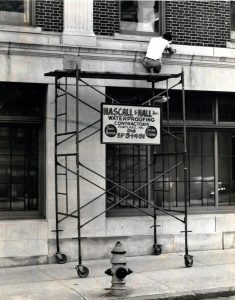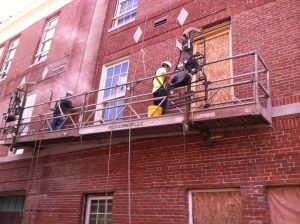 Live Safely all Day – Every Day
Live Safely all Day – Every Day
It’s no secret that masonry construction is one of the most demanding and dangerous of jobs, with a high possibility for work-related injuries.
Since 1948, Hascall & Hall has been assisting in the preservation of some of the most historic and prominent buildings in New England, many of which require us to work at substantial heights. It can be dangerous work that is certainly not for the faint of heart.
Back in the day, there was virtually no safety equipment – workers “hung” on swing gear with only one rail across the back of their rig and nothing on the ends to prevent the worker from falling. Workers wore baseball caps and the like instead of hard hats; the only glasses worn were to correct their vision.
Injuries in 1950 were close to 10 of every 100 full-time workers, and on-the-job deaths in the 1950’s were 13,000 to 16,000 annually. Employers were reluctant at best to implement safety protocol within their businesses believing it wasn’t necessary. In fact, industrial hygienist Louis S. Beliczky recalls the years between 1949 and 1958 as a time when it was extremely difficult to get employers or workers to act on safety “unless people saw the blood drip”.
The federal government’s establishment of the Occupational Health and Safety Administration (OSHA) in 1971 has had a profound effect on the way the construction industry (and industry as a whole) operates from a safety standpoint. And although implementation of the OSH Act was met with much resistance, it has saved lives. Fatal injuries in 2012 were 4,383 for all industries, and in construction non-fatal injuries dipped to an all-time low of just under 4 per 1,000 workers. These numbers are still too high, but there is no denying this is a significant improvement.
of just under 4 per 1,000 workers. These numbers are still too high, but there is no denying this is a significant improvement.
The most important aspect is that workplace safety continues to evolve and has a significant place in the daily lives of workers. At Hascall & Hall, Safety is our #1 Priority, all day – every day.
